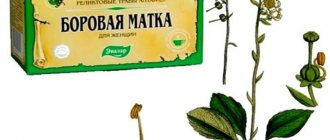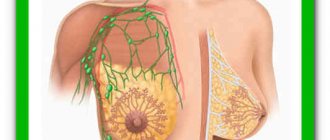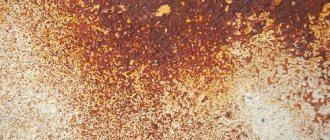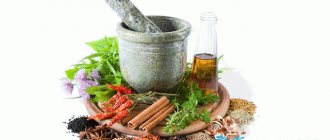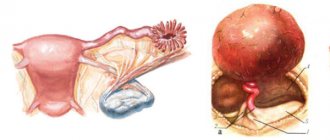PCOS (polycystic ovary syndrome) is manifested by a disruption of the reproductive system of a woman, affecting the activity of the endocrine organs as a whole. This disease is characterized by serious abnormalities in the functioning of the reproductive system, pancreas, adrenal glands and hypothalamic-pituitary zone.
Due to multilateral damage, therapy for polycystic disease is quite lengthy and is accompanied by the need for constant use of medications. Often, patients are forced to interrupt the course of treatment due to allergies to medications and the development of side effects.
Treatment of polycystic ovary syndrome with folk remedies is considered one of the methods of helping women suffering from pathological cystic enlargement of the appendages and anovulatory cycles. Such therapy does not have negative consequences in the form of side effects, as with synthetic drugs. However, even the most natural remedy requires compliance with the rules of administration and consideration of contraindications.
What it is?
Polycystic ovary syndrome is mainly caused by endocrine diseases that negatively affect the genitals. The disease disrupts the ovulation process. With polycystic disease, the ovaries increase their size significantly, and the growth of the dominant follicle is disrupted. As a result of such changes, the ovulatory process is disrupted and infertility develops.
- many small follicles are formed in the ovaries (there is no dominant follicle);
- the ovaries can increase three times in size;
- a woman's reproductive function is significantly impaired;
- in most cases, it is not possible to completely get rid of the disease, but you can significantly reduce its symptoms and restore ovarian function;
- In the absence of timely treatment, polycystic disease can cause the development of cancer of the female reproductive organs.
Polycystic ovary syndrome can have a primary and secondary form. In the first case, the disease develops exclusively in adolescence. The second type of disease affects older women.
Reasons for development
The main reason for the development of polycystic ovary syndrome is considered to be a disruption of the endocrine system. This deviation leads to a change in natural processes in the body. The condition can be aggravated by a decrease in immunity that occurs under the influence of various factors. The consequence of the disease is not only the functioning of the ovaries, but also the adrenal glands.
The causes of polycystic ovary syndrome include the following factors:
- autoimmune changes in the body;
- endocrine diseases;
- genetic predisposition;
- chronic diseases of the pharyngeal tonsils;
- disruption of the synthesis of female sex hormones;
- increasing insulin production in the body;
- protracted infectious diseases;
- excess pituitary hormones;
- constant stressful situations and abnormalities in the functioning of the nervous system;
- increasing testosterone in a woman’s body;
- sudden changes in climatic conditions;
- unfavorable environmental factors.
Symptoms and diagnosis
With the development of polycystic ovary syndrome, pain may not occur immediately. A disorder can be suspected by the appearance of facial hair, acne, and sudden weight gain. In medical practice, there are many examples where in a short period of time women added 10-15 kg to their body weight. The most common reason for contacting specialists for polycystic disease is complaints of lack of pregnancy.
Symptoms of the disease may include the following conditions:
- lack of conception for a long time;
- menstrual irregularities;
- the appearance of excess weight;
- pain in the ovarian area;
- increased greasiness of hair and skin;
- acne on the face;
- decrease in voice timbre;
- increase in the amount of hair on the body.
With polycystic ovary syndrome, patients have complaints of irregular menstruation, lack of pregnancy and sudden scanty bleeding from the vagina. Based on these data and the results of the woman’s examination, the doctor draws up an approximate clinical picture of her health condition. To confirm the diagnosis, additional examinations are necessary.
Methods for diagnosing the disease include the following procedures:
- Ultrasound of the pelvic organs (the procedure allows you to determine the size of the ovaries and the development of cysts);
- general blood and urine analysis;
- blood test to determine the level of pituitary hormones;
- MRI (the procedure eliminates the possibility of developing tumors);
- laparoscopy (the procedure confirms abnormalities developing in the ovaries);
- blood test for glucose and insulin;
- study of lipid levels.
Mechanism and symptoms of the disease
The structure of a woman’s ovaries is heterogeneous and consists of many follicles. Once a month, one (or more) follicles should rupture and be released from the ovaries. With polycystic disease, the follicle also grows, but rupture does not occur - the egg does not leave the ovary. And the follicle forms a cyst filled with fluid under the lining of the ovary. Over time, the ovarian tissue is completely replaced by cystic formations. Because of this disease, a woman cannot become pregnant.
- absence or infrequent menstruation;
- overweight without overeating;
- purulent rashes on the face and body, increased oily skin;
- excessive hair growth;
- loss of reproductive function.
- examination by a gynecologist, an increase in the size of the ovaries can be noted already during bimanual diagnosis;
- ultrasonography;
- hormone tests;
- laparoscopy to confirm the diagnosis.
We treat problems with the ovaries using traditional recipes
What can you do yourself at home? Since the disease contributes to unmotivated weight gain, it is imperative to monitor your diet. The menu should be varied and balanced. Surely you will also be interested in the article Treatment of anovulation with folk remedies, in which you will find many useful recipes for yourself.
Is traditional treatment effective?
A mandatory step in the treatment of polycystic ovary syndrome is hormone replacement therapy and computer reflexology. The first method temporarily destroys excess hormones and replaces their missing part. The second method is aimed at restoring the secretion of sex hormones.
Folk remedies cannot cope with such problems. Alternative medicine prescriptions show good results as a complementary treatment measure.
Thanks to the use of folk remedies, the following results can be obtained:
- accelerating the process of hormonal restoration;
- normalization of the menstrual cycle;
- increasing the protective functions of the body;
- improvement of the general condition of the body.
Nutrition for illness
During the period of treatment of polycystic disease with traditional medicine, you should follow a special diet. With its help, the treatment process is accelerated, the body's immune strength is restored and metabolic processes are improved. Dietary rules during treatment for polycystic ovary syndrome:
- eating 5-6 times a day in small portions,
- inclusion in the diet of greens, flax seeds, nuts, red fish,
- replacing regular vegetable oil with olive and flaxseed oil,
- drink plenty of fluids – at least 2 liters per day,
- eating fruits and vegetables high in fiber - pears, kiwi, oranges, apples, zucchini, cabbage,
- daily intake of fermented milk and dairy products,
- limiting the consumption of salt, sweets, flour, fatty, spicy, smoked foods.
The food consumed should be easily digestible and as beneficial as possible for the body. The diet must be prepared taking into account the content of nutrients in foods and medicines.
Popular home recipes
There are several varieties of herbs that have good adaptogenic properties. Such components speed up the process of treating thyroid diseases and have a beneficial effect on female body functions.
- Grind the dandelion root and divide into 2 g portions
- Every day, thirty minutes before meals, three times a day, brew tea based on the preparation.
- For 2 g of preparation you will need one cup of boiling water.
- Before use, the product must be infused for 15-20 minutes.
Red brush treatment:
- Pour one tablespoon of red brush roots (Rhodiola tetrapartite) into one glass of boiling water.
- Leave the preparation for one hour.
- You should take the product before meals, one third of a glass three times a day.
- You can prepare an alcohol tincture from red brush (for 500 ml of vodka you will need 80 g of crushed roots).
- The alcohol tincture must be infused for at least seven days in a dark and cool place.
- You should take this remedy half a teaspoon three times a day before meals.
Medicinal mixture for polycystic ovary syndrome:
- In equal quantities, mix the crushed roots of red brush, hogweed, shepherd's purse grass, rowan fruits (there are red and black) and leuzea (one tablespoon of each ingredient).
- Grind the mixture of herbs with a blender or coffee grinder.
- Pour two tablespoons of the resulting powder into a thermos with 500 ml of boiling water.
- Infuse the preparation for 10 hours.
- For two to three months, take half a glass of infusion three times a day before meals.
- Dilute the mummy with a small amount of warm water to obtain a thick but homogeneous mass.
- Let the mixture sit for an hour, then stir again.
- Make a tampon from a bandage, moisten it in diluted mummy and insert it into the vagina overnight.
- The course of treatment with this remedy is 10 days.
- It is prohibited to perform procedures during menstruation.
Diet and therapy
Among the methods of folk treatment there are: herbal decoctions and tinctures, medicinal tampons, compresses and even hirudotherapy. Proper nutrition also plays a very important role, on which the production of hormones depends.
Diet and nutrition
Polycystic ovary syndrome is a hormonal disease, so it is very important to follow a proper diet when treating this disease.
The diet should be aimed at reducing a woman’s weight, stimulating the production of necessary hormones and replenishing vitamin deficiency.
It is necessary to consume foods that have a low hypoglycemic index (less than 50), such as:
Increase
- Eggs, fish and meat;
- Cereal products;
- Cottage cheese, yogurt, fermented milk products;
- Soybeans, beans, rye bread;
- Vegetables, cucumbers, cabbage, tomatoes, mushrooms;
- Fruits, pears, apples, cherries, citrus fruits.
It is necessary to exclude strong tea and coffee, alcohol, and animal fats, as they unnecessarily burden the liver. And with polycystic ovary syndrome, liver dysfunction often occurs. Lard, smoked foods and margarine should also be excluded. About how to eat with polycystic ovary syndrome.
Tampons with mumiyo
Shilajit is a natural organic, mineral product that contains more than 30 useful and medicinal elements.
For polycystic ovary syndrome, mumiyo is used as follows: 100 g. The product must be diluted in a small amount of warm (boiled) water. After the substance softens, mix and moisten a tampon in the resulting composition. Insert the tampon with mummy into the vagina overnight. The course of treatment is approximately 9-10 days. This product should not be used during menstruation.
Hirudotherapy for PCOS
Hirudotherapy (treatment with leeches) for polycystic ovary syndrome promotes recovery.
Leech saliva contains a huge amount of useful substances, almost the entire periodic table. This method helps restore lymph flow, strengthen the immune system, and eliminate inflammation, if present. The duration of the course of treatment is prescribed by a specialist.
What is not recommended to use?
When disturbances in the functioning of the endocrine system occur, complex treatment is necessary. The body cannot restore functions on its own. That is why you should never ignore the symptoms of polycystic ovary syndrome. The disease can have serious consequences, such as, for example, infertility or the development of cancer of the woman’s genital organs.
It is not recommended for polycystic ovary syndrome:
- perform hot and cold wraps, lymphatic drainage and other similar procedures;
- self-medicate;
- drink large quantities of coffee and sweet juices;
- abuse bad habits;
- ignore the recommendations of specialists;
- use traditional medicine as the main method of treatment;
- expose the body to excessive physical stress;
- being exposed to the sun too often;
- visit baths, saunas and take hot baths.
Other folk recipes
In some cases, polycystic ovary syndrome is aggravated by other diseases or the condition of the woman’s body. To achieve this, treatment tactics change - traditional medicine recipes in this case are aimed at eliminating both the main pathology and the accompanying one. During pregnancy, therapy is difficult due to the inability to use most herbs and other remedies.
Reviews from patients
Inga, 36 years old
I had to treat polycystic ovary syndrome for a long time. I used medication and experimented with folk remedies. I made tampons with mumiyo and used herbal infusions.
It was possible to restore the functions of the ovaries, but it has not yet been possible to completely get rid of the disease. Intensive therapy had to be carried out when planning pregnancy. Conception occurred and it was possible to carry the child to term without complications. Now I continue the course of treatment.
Anna, 25 years old
After the diagnosis of polycystic ovary syndrome was established, I began to look for treatment methods to avoid surgery. I found a lot of recommendations on the Internet, but not all of them inspired confidence.
I opted for flax seeds and herbal infusions. In any case, herbs will not harm the body, and flax has a beneficial effect on the skin and hair.
I regularly use decoctions and infusions. At my last visit to the gynecologist, there was a trend towards improvement in my health.
Svetlana, 32 years old
I found out about polycystic ovary syndrome by accident. A few years ago I began to gain weight, and acne appeared on my face. There were no painful sensations. I didn’t pay attention to the symptoms. My cycle has always been irregular, and I attributed the changes in appearance to hormonal imbalance. Upon examination, the gynecologist suspected the development of polycystic disease. She underwent examination and the diagnosis was confirmed.
I had to make a lot of efforts to treat the thyroid gland and eliminate abnormalities in the ovaries. She took medications prescribed by the doctor and drank herbal infusions, as well as a decoction of red brush. Now the cycle has become more regular, the weight has begun to decrease, and the condition of the skin has improved. The gynecologist also noted good results of treatment.
Polycystic ovary syndrome: symptoms and treatment with folk remedies
PCOS (polycystic ovary syndrome) is manifested by a disruption of the reproductive system of a woman, affecting the activity of the endocrine organs as a whole. This disease is characterized by serious abnormalities in the functioning of the reproductive system, pancreas, adrenal glands and hypothalamic-pituitary zone.
Due to multilateral damage, therapy for polycystic disease is quite lengthy and is accompanied by the need for constant use of medications. Often, patients are forced to interrupt the course of treatment due to allergies to medications and the development of side effects.
Treatment of polycystic ovary syndrome with folk remedies is considered one of the methods of helping women suffering from pathological cystic enlargement of the appendages and anovulatory cycles. Such therapy does not have negative consequences in the form of side effects, as with synthetic drugs. However, even the most natural remedy requires compliance with the rules of administration and consideration of contraindications.
General recommendations on nutrition, treatment and prevention
Using traditional methods, you need to simultaneously adhere to a diet and take medications containing hormones.
The diet must include foods that promote weight loss, normalize hormonal levels, and replenish vitamin deficiencies. These include:
- Cucumbers, tomatoes, cabbage.
- Lean meat and fish.
- Fermented milk products.
- Apples, pears, citrus.
It is recommended to reduce or eliminate the amount of tea, coffee, and alcoholic beverages you drink. It is also not advisable to eat lard and spreads, which overload the liver. The consumption of proteins (no more than 20 g), simple carbohydrates (up to 80 g) and sweets is limited.
During treatment, it is necessary to establish a psycho-emotional background, because hormonal balance depends on this. You can drink teas with chamomile, lemon balm or mint, adding honey instead of sugar. With the permission of the gynecologist, physiotherapy is possible, including massage and hydromassage, swimming, herbal bath, Charcot shower. Oral contraceptives are also prescribed. They do not treat pathology, but create an artificial balance of hormones.
For prevention purposes, a woman needs to monitor her lifestyle and body weight, as well as regularly exercise physical activity. It is better to eat more often, but in small portions. You can take healthy supplements, attend yoga classes, and consume chromium. The substance is found in optimal quantities in broccoli, red wine, and green beans. Remember, there is no single cure for polycystic ovary syndrome; the pathology must be dealt with comprehensively.
What is polycystic ovary syndrome and how is it treated? Polycystic ovary syndrome (PCOS) refers to diseases of the female hormonal system. Due to a malfunction in this system, women experience irregularities in the menstrual cycle and a failure in the maturation of eggs. Only properly selected therapy can cure such a disease. You can take advantage of the achievements of modern medicine and supplement the treatment of polycystic ovary syndrome with folk remedies.
Features of traditional treatment
The main goals of alternative treatment for a patient with polycystic ovaries:
- restoration of the normal menstrual cycle;
- elimination of excessive hyperandrogenism (minimizing the manifestation of increased concentrations of male sex steroids);
- weight normalization;
- correction of metabolic disorders.
For polycystic ovary syndrome, traditional treatment methods are selected individually. You should not use herbs that are recommended by friends. Medicinal plants contain many components, which, if a woman has certain concomitant diseases, can cause complications.
How to treat polycystic ovary syndrome with folk remedies
Treatment of polycystic ovary syndrome without hormones is almost impossible. That is why, as an alternative, the use of medicinal plants containing natural analogues of human steroids is indicated. Like any hormonal drug, traditional methods of treating PCOS have limitations, contraindications, maximum permissible doses, frequency and administration characteristics. It is important to remember that herbs and drugs often cause severe allergic reactions.
Folk remedies as part of complex therapy
To achieve results faster, traditional medicine is combined with other types of treatment. To eliminate polycystic ovary syndrome, certain types of medications and physical procedures are used. All three methods can be used simultaneously if all doctor’s recommendations are followed and there is no interaction.
Medications used simultaneously with folk remedies for the treatment of polycystic ovary syndrome:
- anti-inflammatory,
- painkillers,
- improving blood microcirculation,
- normalizing blood pressure,
- vitamin complexes,
- immunostimulants.
Many folk remedies are contraindicated for use simultaneously with hormonal drugs and oral contraceptives.
Physiotherapy for the treatment of polycystic disease, compatible with traditional medicine methods:
- magnetotherapy,
- water and mud baths,
- galvanophoresis,
- paraffin treatment.
Independent choice of treatment methods and the possibility of combining them is strictly prohibited - this can aggravate the course of polycystic ovary syndrome.
Herbs for polycystic ovary syndrome
Plant phytoestronenes are similar in structure to female hormones. Treatment of polycystic disease occurs when substances are supplied from outside and the production of some steroids decreases while others increase.
How to take boron uterus for polycystic ovary syndrome
Ortilia or boron uterus is considered one of the most popular and frequently used plants in gynecology. Has anti-inflammatory and immunomodulatory effects. Phytohormones contribute to the normalization of the menstrual cycle and the appearance of ovulation. Saponins increase the likelihood of conception, which, by acting on the glandular structures of the endometrium, make the inner lining more pliable for receiving a fertilized egg.
Borovaya uterus for polycystic ovary syndrome is indicated for use in patients suffering from hypertension. This analogue of anticoagulants reduces the risk of developing vascular complications.
Ortilia tincture is best consumed in the first half of the day, an hour after meals.
The folk remedy has a negative effect on the gastrointestinal tract and is contraindicated in women with peptic ulcers and liver dysfunction. You can start herbal treatment on any day of the cycle, but during your period, you must stop taking the plant.
Sage for polycystic ovary syndrome
Traditional treatment of PCOS with sage is possible only after consultation with your doctor. The drug has an estdadiol-stimulating effect. With excess estrogen production, an additional increase in female sex steroids from the outside leads to an intensification of polycystic disease. Sage is indicated exclusively for normal or reduced blood estradiol levels.
Treating PCOS at home
Traditional medicine has accumulated over its centuries-old history a large number of medicinal recipes that can relieve various gynecological problems, including the cure of polycystic ovaries.
The following plants and herbs are considered the most effective for polycystic disease:
- licorice;
- hog uterus;
- dandelion;
- red brush;
- mint;
- horsetail;
- basil;
- oregano;
- stinging nettle;
- marin root.
Before treating polycystic ovary syndrome with folk remedies, you need to know in what form plant materials are used. Infusions and decoctions with herbs are mainly used. They are used as drinks, made into compresses or soaked in tampons for internal use.
Basic Home Remedies for PCOS:
Pour a dessert spoon of soda, slaked with 9% vinegar, into a three-liter jar, add a glass of vodka, and fill the jar with warm boiled water. Everything is mixed. Soak a cotton cloth in the resulting product and apply a compress to the abdominal area at night. You need to keep it on all night. Treatment of polycystic ovary syndrome is carried out over 14 days. Then a break is taken for a month and, if necessary, the course is repeated. But it is strictly forbidden to use such compresses in the presence of tumors.
Pour 3 tablespoons of warm water into a plate and add 10 grams of mumiyo. After 60 minutes, the mummy should swell and it must be stirred to a uniform consistency. Soak a tampon in this solution and insert it into the vagina overnight. The course of therapy is no more than 10 days.
This plant is considered one of the most effective used to restore women's health. Borovaya uterus for polycystic ovary syndrome combines well with other drugs, and treatment courses can be carried out for a long time.
To prepare an alcoholic infusion, you need to pour 100 grams of boron uterus with half a liter of vodka, put it in a dark place to infuse for 7 days. You need to take the resulting drug three times a day, half a teaspoon.
With another version of the infusion, you need to pour a tablespoon of medicinal herb with 200 milliliters of boiling water and let it stand for a couple of hours. The resulting medicine should be taken within one day.
Red brush can be used simultaneously with boron uterus for polycystic ovary syndrome to double the therapeutic effect.
To prepare an infusion of red brush for PCOS, you need to pour 100 grams of the plant with half a liter of vodka, mix everything well and put it in a dark place for a week. The resulting tincture should be consumed one teaspoon three times a day.
Other folk remedies for polycystic ovary syndrome
In addition to medicinal herbs, there are other equally effective folk methods for treating the disease. These include diet, hirudotherapy, tampons and compresses for polycystic ovary syndrome.
Flax seeds for polycystic ovary syndrome
Flaxseeds contain substances that help increase the concentration of sex steroid binding globulin. As a result, excess testosterone and its derivatives are eliminated. In patients, the following manifestations of hyperandrogenism in polycystic disease decrease:
- male-type weight gain in the abdominal area;
- hirsutism (excessive body hair growth);
- acne;
- alopecia;
- striae.
Flax seeds help reduce glucose absorption, which eliminates the manifestations of disorders of the pancreas and cardiovascular system.
Leeches for polycystic ovary syndrome
Hirudotherapy for polycystic disease has a number of advantages:
- increases immunity;
- improves microcirculation;
- eliminates swelling;
- normalizes hormonal levels;
- slows down the replacement of ovarian tissue with connective tissue;
- reduces cystic transformation;
- affects reflexogenic points.
Traditional treatment with leeches is contraindicated for thrombotic diseases, coagulation disorders, tumors, pregnancy and arterial hypertension.
Flaxseed oil for polycystic ovary syndrome
The folk remedy contains a large amount of healthy fatty acids, promotes weight loss and normalizes testosterone levels.
Chaga for polycystic ovary syndrome
By balancing the content of estrogen and progesterone, chaga helps to normalize the cycle. Take the folk remedy in combination with other plants.
Mumiyo
Tampons with mumiyo help increase local immunity and have an antibacterial and anti-inflammatory effect. The substance is rich in vitamins, blocks excessive release of prostaglandins and eliminates pain during menstruation.
Cinnamon
The spice helps normalize the menstrual cycle by activating hypothalamic hormones. The effectiveness of this seasoning has been confirmed by foreign studies. The fact of weight loss and elimination of glucose tolerance has been established. To achieve results, it is recommended to consume a teaspoon of cinnamon per day. The maximum daily dose is 2 teaspoons.
Inositol
This substance is an analogue of B vitamins. The substance is found in food products, however, there are ready-made food supplements of the well-studied myo-inositol.
For polycystic disease, the drug helps normalize the disrupted menstrual cycle, reduce testosterone levels and increase insulin sensitivity. The medicine helps eliminate unpleasant symptoms and increases the chance of natural conception.
The nuances of using alternative medicine in the treatment of PCOS
Traditional medicine methods are used in addition to conservative and surgical treatment of polycystic ovary syndrome. The use of these funds is permissible in the following situations:
- At the stage of weight correction and normalization of metabolic processes. Some herbal remedies and alternative medicine techniques eliminate insulin resistance and stabilize metabolism;
- When prescribing hormonal drugs. Many herbal preparations reduce the level of androgens, normalize the content of estrogen and progesterone, and affect the production of pituitary and pancreatic hormones. The effect of herbal remedies is weak and cannot be compared with the effect of medications. Herbal remedies cannot be a substitute for full-fledged therapy. They are used as an auxiliary measure;
- After surgical treatment. Herbal medicines accelerate tissue regeneration and promote recovery. They help the body recover after surgery;
- After completing the entire course of treatment. Herbal remedies are used to improve the general condition of the patient;
- At any stage of therapy to increase vitality and strengthen the immune system.
Traditional methods of treatment should be used only as an auxiliary therapy, but not as the main method of treatment.
On a note
The use of traditional medicine recipes must be agreed with your doctor. It is important to know the exact diagnosis, the severity of the disease and realistically assess your chances of recovery and conceiving a child.
It is not recommended to get carried away with “grandmother’s recipes” if such conditions develop against the background of polycystic ovary syndrome:
- Hyperplastic process of the endometrium. Thickening of the mucous layer of the uterus is accompanied by the appearance of intermenstrual bleeding from the genital tract. Menstruation becomes heavy and prolonged. Possible uterine bleeding. Some forms of endometrial hyperplasia develop into cancer;
- Diabetes mellitus type 2. Long-term insulin resistance disrupts hormonal balance and leads to the development of severe endocrine diseases. Against the background of diabetes mellitus, the risk of developing vascular pathology increases;
- Myocardial infarction, cerebral stroke. Metabolic failure in PCOS increases the risk of developing severe pathology of the cardiovascular system;
- Diseases of the mammary glands. With PCOS, benign changes are often detected - mastopathy.
It is also useful to read: The use of suppositories in the treatment of ovarian cysts
With the development of concomitant pathology, complex therapy is required. Consultations with specialized specialists are indicated: endocrinologist, mammologist, vascular surgeon. Traditional medicine does not solve the problem. Refusal of medical care threatens the development of severe complications.
If there is no effect from traditional methods of treatment or progression of symptoms, you should turn to traditional medicine.
Diet for PCOS
PCOS is associated with severe hormonal imbalances at various levels. Without following the rules of rational nutrition, treatment of the disease is impossible. Diet is a fundamental component of the treatment of polycystic appendage syndrome, regardless of the chosen tactics for managing the patient. The menu should be dominated by low-calorie dishes that promote weight loss. At the same time, the diet always remains balanced in vitamin and mineral composition.
Causes of the disease
To date, there is no exact data on what exactly causes polycystic ovary syndrome.
Doctors consider heredity to be the main factor, but there are diseases that can trigger the onset of the disease:
- obesity;
- diabetes;
- poisoning of the body;
- acute infections;
- abortions.
We can conclude that women who have a family history of polycystic ovarian disease need to be especially careful, as they are at risk. Also, if there are factors contributing to the development of the disease, you need to pay more attention to your body.
The concept of PCOS
An anomaly such as polycystic ovary syndrome is considered a treatable pathology - the consequences of its impact on the reproductive system can be restored. However, due to the fact that cysts on the ovaries do not always reveal symptoms immediately, and can cause damage to the female body in a chronic form for a long time, sometimes it is not possible to restore fertility.
At the same time, the development of polycystic ovary syndrome damages the immune and hormonal systems of the female body. As a result, with PCOS, the patient may gain significant weight, experience pain and discomfort in the lower back or lower abdomen.
Increased production of male hormones affects the endocrine system, provokes increased production of insulin, which in the future is fraught with the development of diabetes mellitus or a loyal attitude to glucose. Statistics show that more than 60% of all cases of registered polycystic ovary syndrome are characterized by excess weight, male pattern hair, acne, inflammation and accompanying somatic ailments of the genitourinary system.
In addition to the likelihood of developing diabetes and loss of fertility, polycystic ovary syndrome is primarily dangerous because it provokes the appearance of a large number (7-15 pieces) of cystic capsules on the reproductive organs. The ovaries, the tissues of which are affected by tumors, not only noticeably increase in size. They can also spread infection and provoke inflammation and infection of neighboring internal organs and entire systems.
What are the symptoms of polycystic ovary syndrome?
Too wide a list of symptoms of polycystic ovary syndrome often does not give women the opportunity to determine for themselves which disease is causing her concern. Do not delay visiting your doctor if the following symptoms appear:
- Irregular periods;
- Disappearance of menstruation;
- Lack of desired pregnancy;
- High levels of male sex hormones;
- Male pattern obesity;
- Hair loss;
- Spread of age spots on the skin;
- Severe oily skin;
- Acne;
- Seborrhea;
- Discomfort before menstruation without the onset of menstrual flow;
- The spread of wrinkles across the skin in the form of folds;
- Interruption in the process of breathing during sleep;
- Depressive state;
- Constant pain in the lower abdomen.
To diagnose the disease, you need to fully examine the female genitourinary system so as not to confuse such a serious disease with something else. Only a gynecologist can make final conclusions and make an accurate diagnosis. Do not delay contacting a gynecologist.
Complications of polycystic ovary syndrome
If a woman ignores the symptoms, the risk of serious complications of this disease increases. If you do not receive proper treatment in time, you can allow life-threatening diseases to arise:
- Mammary cancer;
- Endometrial cancer;
- Stroke;
- Obesity;
- Diabetes;
- Thrombosis;
- Atherosclerosis.
Due to an imbalance in the hormonal background, women begin to function incorrectly in all systems of the body, undermining her health.
Treatment methods for polycystic ovary syndrome
There are many drugs for hormone therapy that are designed to cure this disease. But the side effects that occur after taking hormonal drugs instill fear of deteriorating your health even further.
However, to cure the disease, it is necessary to normalize the production of female hormones and the overall hormonal balance.
Linen
Since ancient times, flax seeds have been used as an antitoxin agent that reduces inflammation in the body and has a beneficial effect on the functioning of the gastrointestinal tract. They are also rich in omega-3 and omega-6 fatty acids.
Science knows that constant consumption of this plant with food can reduce the level of male sex hormones (androgens), a high concentration of which in the body can lead to polycystic ovary syndrome.
To obtain the maximum effect, it is necessary to take crushed flax seeds (since they can be absorbed in the body in greater quantities than whole ones) or cold-pressed flaxseed oil once a day, 30-40 grams for at least 3 months to obtain a visible result and balance female and male sex hormones.
Basil
Basil is actively used in Ayurveda to treat female diseases. It, like cinnamon, has the ability to reduce insulin in the blood and the concentration of male sex hormones. To get results you need to eat about 10 leaves at breakfast. It is better to eat fresh than dried, as they contain more useful components.
Mint
Peppermint tea is widely used in various fields of medicine, including as a folk remedy for the treatment of polycystic ovary syndrome. Mint tea helps reduce the production of male sex hormones, quenches thirst and has a calming effect on a woman’s nervous system.
A good aid would be to drink mint tea twice a day, which contains at least 5 mg of mint.
Cinnamon
Insulin resistance often causes hormonal imbalances and the development of PCOS. With this form of the disease, it is recommended to include cinnamon in your daily diet and use it as a spice. It will help lower blood sugar, restore the sensitivity of body cells to insulin, due to which sex hormones that affect the development of polycystic disease will return to normal. Cinnamon also needs to be used over a long period of time, and it is better to include it in your life on an ongoing basis.
Evening primrose
Evening primrose oil is used in the treatment. It has a beneficial effect on the level of estrogen and progesterone in the body. The oil contains a large amount of fatty acids, which help balance hormone production. In addition, primrose creates a favorable environment for pregnancy.
Sage
Sage tea is brewed using 1 tsp per glass of hot water. dried plant. It is recommended to drink throughout the day. In addition to its beneficial effect on hormonal levels, it quenches thirst well and has a pleasant taste.
Hog queen
This plant is widely used in folk medicine, has strong anti-inflammatory properties and has a beneficial effect on the hormonal system. When taking it, you need to focus on the cycle, since tinctures and decoctions from boron uterus are effective during a certain period of the cycle. It is recommended to use only in the second half of the cycle, after ovulation. Take for at least 90 days.
If you make a tincture, then pour 80 g of dried leaves with half a liter of vodka and leave for a week. After this, take half a teaspoon three times a day before meals.
